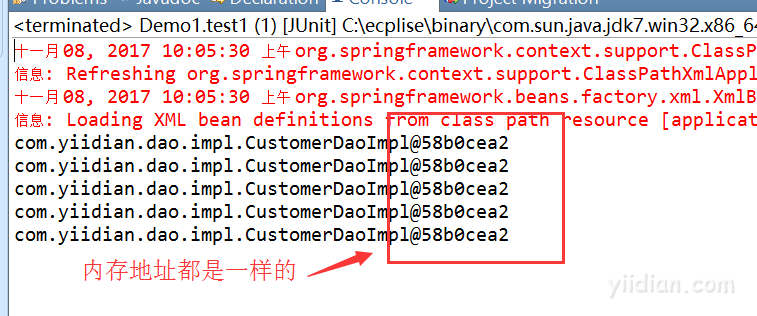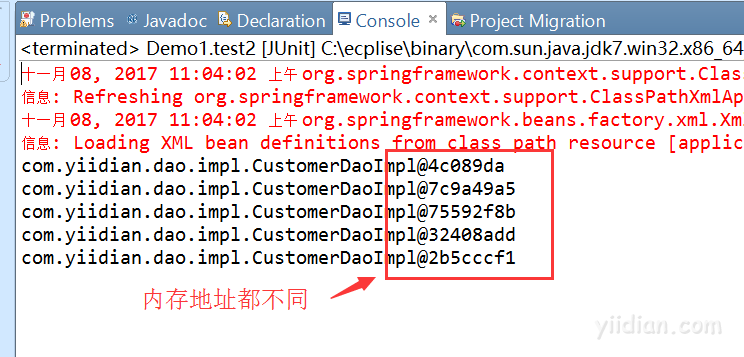SpringIOC的Scope配置
如何使用spring的作用域?
<bean id="customerDao" class="com.yiidian.dao.impl.CustomerDaoImpl" scope="singleton"></bean>
这里的 scope 就是用来配置 spring bean 的作用域,它标识 bean 的作用域。
在spring2.0之前bean只有2种作用域即:singleton(单例)、non-singleton(也称 prototype), Spring2.0以后,增加了session、request、global session三种专用于Web应用程序上下文的Bean。因此,默认情况下Spring2.0现在有五种类型的Bean。当然,Spring2.0对 Bean的类型的设计进行了重构,并设计出灵活的Bean类型支持,理论上可以有无数多种类型的Bean,用户可以根据自己的需要,增加新的Bean类 型,满足实际应用需求。
一、singleton 作用域
当一个bean的 作用域设置为singleton, 那么Spring IOC容器中只会存在一个共享的bean实例,并且所有对bean的请求,只要id与该bean定义相匹配,则只会返回bean的同一实例。换言之,当把 一个bean定义设置为singleton作用域时,Spring IOC容器只会创建该bean定义的唯一实例。这个单一实例会被存储到单例缓存(singleton cache)中,并且所有针对该bean的后续请求和引用都 将返回被缓存的对象实例,这里要注意的是singleton作用域和GOF设计模式中的单例是完全不同的,单例设计模式表示一个ClassLoader中 只有一个class存在,而这里的singleton则表示一个容器对应一个bean,也就是说当一个bean被标识为singleton时 候,spring的IOC容器中只会存在一个该bean。
配置实例:
<bean id="customerDao" class="com.yiidian.dao.impl.CustomerDaoImpl" scope="singleton"></bean>
测试代码:
/**
* 测试singleton
*/
@Test
public void test1(){
ApplicationContext ac = new ClassPathXmlApplicationContext("applicationContext.xml");
for(int i=0;i<=4;i++){
CustomerDao customerDao = (CustomerDao)ac.getBean("customerDao");
System.out.println(customerDao);
}
}
运行结果:

二、prototype作用域
prototype作用域部署的bean,每一次请求(将其注入到另一个bean中,或者以程序的方式调用容器的 getBean()方法)都会产生一个新的bean实例,相当与一个new的操作,对于prototype作用域的bean,有一点非常重要,那就是Spring不能对一个prototype bean的整个生命周期负责,容器在初始化、配置、装饰或者是装配完一个prototype实例后,将它交给客户端,随后就对该prototype实例不闻不问了。不管何种作用域,容器都会调用所有对象的初始化生命周期回调方法,而对prototype而言,任何配置好的析构生命周期回调方法都将不会被调用。 清除prototype作用域的对象并释放任何prototype bean所持有的昂贵资源,都是客户端代码的职责。(让Spring容器释放被singleton作用域bean占用资源的一种可行方式是,通过使用 bean的后置处理器,该处理器持有要被清除的bean的引用。)
配置实例:
<bean id="customerDao" class="com.yiidian.dao.impl.CustomerDaoImpl" scope="prototype"></bean>
测试代码:
/**
* 测试prototype
*/
@Test
public void test1(){
ApplicationContext ac = new ClassPathXmlApplicationContext("applicationContext.xml");
for(int i=0;i<=4;i++){
CustomerDao customerDao = (CustomerDao)ac.getBean("customerDao");
System.out.println(customerDao);
}
}
运行结果:
三、request作用域
request表示该针对每一次HTTP请求都会产生一个新的bean,同时该bean仅在当前HTTP request内有效,配置实例:
request、session、global session使用的时候首先要在初始化web的web.xml中做如下配置:
如果你使用的是Servlet 2.4及以上的web容器,那么你仅需要在web应用的XML声明文件web.xml中增加下述ContextListener即可:
<web-app>
...
<listener>
<listener-class>org.springframework.web.context.request.RequestContextListener</listener-class>
</listener>
...
</web-app>
如果是Servlet2.4以前的web容器,那么你要使用一个javax.servlet.Filter的实现:
<web-app>
..
<filter>
<filter-name>requestContextFilter</filter-name>
<filter-class>org.springframework.web.filter.RequestContextFilter</filter-class>
</filter>
<filter-mapping>
<filter-name>requestContextFilter</filter-name>
<url-pattern>/*</url-pattern>
</filter-mapping>
...
</web-app>
接着既可以配置bean的作用域了:
<bean id="customerDao" class="com.yiidian.dao.impl.CustomerDaoImpl" scope="request"></bean>
四、session作用域
session作用域表示该针对每一次HTTP请求都会产生一个新的bean,同时该bean仅在当前HTTP session内有效。
配置实例:
和request配置实例的前提一样,配置好web启动文件就可以如下配置:
<bean id="customerDao" class="com.yiidian.dao.impl.CustomerDaoImpl" scope="session"></bean>
五、global session作用域
global session作用域类似于标准的HTTP Session作用域,不过它仅仅在基于portlet的web应用中才有意义。Portlet规范定义了全局Session的概念,它被所有构成某个 portlet web应用的各种不同的portlet所共享。在global session作用域中定义的bean被限定于全局portlet Session的生命周期范围内。如果你在web中使用global session作用域来标识bean,那么web会自动当成session类型来使用。
配置实例:
和request配置实例的前提一样,配置好web启动文件就可以如下配置:
<bean id="customerDao" class="com.yiidian.dao.impl.CustomerDaoImpl" scope="global session"></bean>
热门文章
优秀文章



